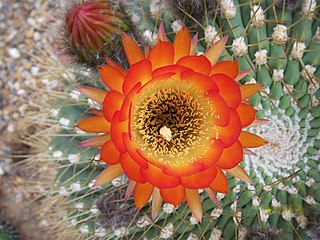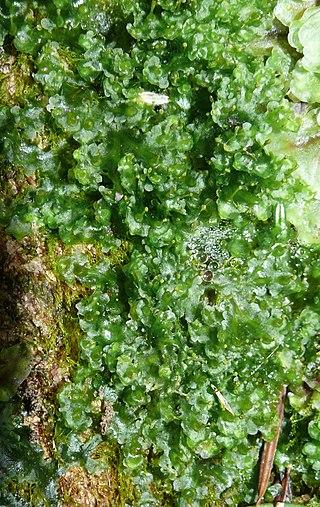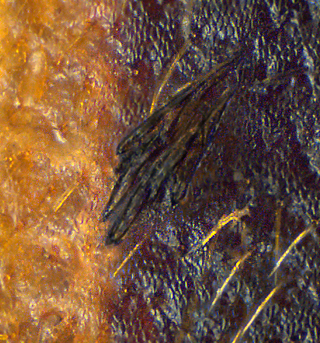
Soehrensia is a large genus of cacti native to South America.

Satakentia liukiuensis, is a species of palm tree. They are endemic to Ishigaki Island and Iriomote Island in the Yaeyama Islands, the south-westernmost of the Ryukyu Islands, Japan. It is the only species in the genus Satakentia.

Blasia pusilla is the only species in the liverwort genus Blasia. It is distinguished from Cavicularia by the presence of a collar around the base of the sporophyte capsule, and a scattered arrangement of sperm-producing antheridia. Rhizoids and gemmae of Blasia may be parasitized by the mushroom Blasiphalia.
Setchellanthus caeruleus is a species of pungent shrub with large blue flowers. It is placed alone in the genus Setchellanthus, which is in turn, is placed alone in the family Setchellanthaceae. It is endemic to Mexico.
Bognera is a monotypic genus of flowering plants in the family Araceae. The single species that makes up the genus is Bognera recondita. The word recondita means "hidden" referring to the fact that the plant is only found in remote areas of Amazonian Brazil near the Peruvian border. The species was discovered in the late 1970s and was originally placed in the genus Ulearum, as Ulearum reconditumMadison, Aroideana 3: 101 (1980).

Laboulbenia is a genus of fungi in the family Laboulbeniaceae.
Speerschneidera is a single-species genus of lichen-forming fungi in the family Leprocaulaceae. The genus was circumscribed by Italian botanist Vittore Benedetto Antonio Trevisan de Saint-Léon in 1861, with Speerschneidera euploca as the type species. This lichen was originally described by Edward Tuckerman in 1858 as Physcia euploca. It is a crustose lichen found in the southern United States and Mexico.
Tribulatia is a genus of fungi in the family Phyllachoraceae. This is a monotypic genus, containing the single species Tribulatia appendicospora.
Heufleria is a genus of fungi in the Rhytismatales order.
Duboscquella is a genus of dinoflagellates.

Brigantiaea is a genus of lichen-forming fungi in the family Brigantiaeaceae. It was circumscribed by Italian botanist Vittore Benedetto Antonio Trevisan de Saint-Léon in 1853.

The Mixiomycetes are a class of fungi in the Pucciniomycotina subdivision of the Basidiomycota. The class contains a single order, the Mixiales, which in turn contains a single family, the Mixiaceae that circumscribes the monotypic genus Mixia. Only one species has been described to date, Mixia osmundae; this species was originally named Taphrina osmundae by Japanese mycologist Toji Nishida in 1911. It is characterized by having multinucleate hyphae, and by producing multiple spores on sporogenous cells.

Holwaya is a genus of fungi in the family Bulgariaceae. Holwaya is monotypic, containing the single species Holwaya mucida, which was originally named Bulgaria ophiobolus by Job Bicknell Ellis in 1883, and later transferred to the newly created Holwaya by Pier Andrea Saccardo in 1889. The genus name of Holwaya is in honour of Edward Willet Dorland Holway (1853-1923), who was an American botanist (Mycology) and Banker.
Vittore Benedetto Antonio Trevisan de Saint-Léon was an Italian botanist who specialized in cryptogamic flora.
Hyellaceae is a family of cyanobacteria.

Delisea is a genus of red algae in the family Bonnemaisoniaceae.

Surirella is a genus of diatoms in the family Surirellaceae.

Delesseria is a genus of red algae belonging to the family Delesseriaceae.
Trabutiella is a genus of fungi in the family Phyllachoraceae.










